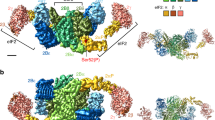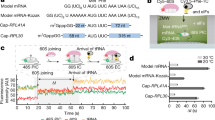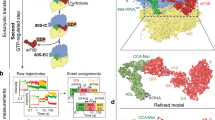Abstract
In protein synthesis initiation, the eukaryotic translation initiation factor (eIF) 2 (a G protein) functions in its GTP-bound state to deliver initiator methionyl-tRNA (tRNAiMet) to the small ribosomal subunit and is necessary for protein synthesis in all cells1,2. Phosphorylation of eIF2 [eIF2(αP)] is critical for translational control in diverse settings including nutrient deprivation, viral infection and memory formation3,4,5. eIF5 functions in start site selection as a GTPase accelerating protein (GAP) for the eIF2·GTP·tRNAiMet ternary complex within the ribosome-bound pre-initiation complex6,7,8. Here we define new regulatory functions of eIF5 in the recycling of eIF2 from its inactive eIF2·GDP state between successive rounds of translation initiation. First we show that eIF5 stabilizes the binding of GDP to eIF2 and is therefore a bi-functional protein that acts as a GDP dissociation inhibitor (GDI). We find that this activity is independent of the GAP function and identify conserved residues within eIF5 that are necessary for this role. Second we show that eIF5 is a critical component of the eIF2(αP) regulatory complex that inhibits the activity of the guanine-nucleotide exchange factor (GEF) eIF2B. Together our studies define a new step in the translation initiation pathway, one that is critical for normal translational controls.
This is a preview of subscription content, access via your institution
Access options
Subscribe to this journal
Receive 51 print issues and online access
$199.00 per year
only $3.90 per issue
Buy this article
- Purchase on Springer Link
- Instant access to full article PDF
Prices may be subject to local taxes which are calculated during checkout




Similar content being viewed by others
References
Kapp, L. D. & Lorsch, J. R. The molecular mechanics of eukaryotic translation. Annu. Rev. Biochem. 73, 657–704 (2004)
Sonenberg, N. & Hinnebusch, A. G. Regulation of translation initiation in eukaryotes: mechanisms and biological targets. Cell 136, 731–745 (2009)
Scheuner, D. et al. Control of mRNA translation preserves endoplasmic reticulum function in beta cells and maintains glucose homeostasis. Nature Med. 11, 757–764 (2005)
Costa-Mattioli, M. et al. eIF2α phosphorylation bidirectionally regulates the switch from short- to long-term synaptic plasticity and memory. Cell 129, 195–206 (2007)
Mohr, I. Neutralizing innate host defenses to control viral translation in HSV-1 infected cells. Int. Rev. Immunol. 23, 199–220 (2004)
Algire, M. A., Maag, D. & Lorsch, J. R. Pi release from eIF2, not GTP hydrolysis, is the step controlled by start-site selection during eukaryotic translation initiation. Mol. Cell 20, 251–262 (2005)
Das, S., Ghosh, R. & Maitra, U. Eukaryotic translation initiation factor 5 functions as a GTPase-activating protein. J. Biol. Chem. 276, 6720–6726 (2001)
Paulin, F. E. et al. Eukaryotic translation initiation factor 5 (eIF5) acts as a classical GTPase-activator protein. Curr. Biol. 11, 55–59 (2001)
Cheung, Y. N. et al. Dissociation of eIF1 from the 40S ribosomal subunit is a key step in start codon selection in vivo . Genes Dev. 21, 1217–1230 (2007)
Unbehaun, A., Borukhov, S. I., Hellen, C. U. & Pestova, T. V. Release of initiation factors from 48S complexes during ribosomal subunit joining and the link between establishment of codon-anticodon base-pairing and hydrolysis of eIF2-bound GTP. Genes Dev. 18, 3078–3093 (2004)
Singh, C. R. et al. An eIF5/eIF2 complex antagonizes guanine nucleotide exchange by eIF2B during translation initiation. EMBO J. 25, 4537–4546 (2006)
DerMardirossian, C. & Bokoch, G. M. GDIs: central regulatory molecules in Rho GTPase activation. Trends Cell Biol. 15, 356–363 (2005)
Pavitt, G. D., Ramaiah, K. V., Kimball, S. R. & Hinnebusch, A. G. eIF2 independently binds two distinct eIF2B subcomplexes that catalyze and regulate guanine-nucleotide exchange. Genes Dev. 12, 514–526 (1998)
Schmitt, E., Blanquet, S. & Mechulam, Y. The large subunit of initiation factor aIF2 is a close structural homologue of elongation factors. EMBO J. 21, 1821–1832 (2002)
Asano, K. et al. Conserved bipartite motifs in yeast eIF5 and eIF2Bepsilon, GTPase- activating and GDP–GTP exchange factors in translation initiation, mediate binding to their common substrate eIF2. EMBO J. 18, 1673–1688 (1999)
Asano, K. et al. Multiple roles for the C-terminal domain of eIF5 in translation initiation complex assembly and GTPase activation. EMBO J. 20, 2326–2337 (2001)
Conte, M. R. et al. Structure of the eukaryotic initiation factor (eIF) 5 reveals a fold common to several translation factors. Biochemistry 45, 4550–4558 (2006)
Wei, Z., Xue, Y., Xu, H. & Gong, W. Crystal structure of the C-terminal domain of S. cerevisiae eIF5. J. Mol. Biol. 359, 1–9 (2006)
Alone, P. V. & Dever, T. E. Direct binding of translation initiation factor eIF2γ-G domain to its GTPase-activating and GDP-GTP exchange factors eIF5 and eIF2Bε. J. Biol. Chem. 281, 12636–12644 (2006)
Hinnebusch, A. G. Translational regulation of GCN4 and the general amino acid control of yeast. Annu. Rev. Microbiol. 59, 407–450 (2005)
Singh, C. R. et al. Eukaryotic translation initiation factor 5 is critical for integrity of the scanning preinitiation complex and accurate control of GCN4 translation. Mol. Cell. Biol. 25, 5480–5491 (2005)
Ramirez, M. et al. Mutations activating the yeast eIF-2α kinase GCN2: isolation of alleles altering the domain related to histidyl-tRNA synthetases. Mol. Cell. Biol. 12, 5801–5815 (1992)
Pavitt, G. D., Yang, W. & Hinnebusch, A. G. Homologous segments in three subunits of the guanine nucleotide exchange factor eIF2B mediate translational regulation by phosphorylation of eIF2. Mol. Cell. Biol. 17, 1298–1313 (1997)
Dever, T. E. et al. Modulation of tRNAi Met, eIF-2 and eIF-2B expression shows that GCN4 translation is inversely coupled to the level of eIF-2.GTP.Met-tRNAi Met ternary complexes. Mol. Cell. Biol. 15, 6351–6363 (1995)
Krishnamoorthy, T. et al. Tight binding of the phosphorylated alpha subunit of initiation factor 2 (eIF2α) to the regulatory subunits of guanine nucleotide exchange factor eIF2B is required for inhibition of translation initiation. Mol. Cell. Biol. 21, 5018–5030 (2001)
Mohammad-Qureshi, S. S. et al. Critical contacts between the eukaryotic initiation factor 2B (eIF2B) catalytic domain and both eIF2β and -2γ mediate guanine nucleotide exchange. Mol. Cell. Biol. 27, 5225–5234 (2007)
Adams, A., Gottschling, D. E., Kaiser, C. A. & Stearns, T. Methods in Yeast genetics: A Cold Spring Harbor Laboratory Course Manual (Cold Spring Harbor Laboratory Press, 1998)
Gietz, R. D. & Woods, R. A. Transformation of yeast by lithium acetate/single-stranded carrier DNA/polyethylene glycol method. Methods Enzymol. 350, 87–96 (2002)
Phan, L. et al. Identification of a translation initiation factor 3 (eIF3) core complex, conserved in yeast and mammals, that interacts with eIF5. Mol. Cell. Biol. 18, 4935–4946 (1998)
Acknowledgements
We thank K. Asano for plasmids and yeast strains, and discussions, and M. Ashe and members of the Pavitt and Ashe labs for discussions. This work was supported by grants BB/E002005/1 and BB/H010599/1 from the BBSRC to G.D.P.
Author information
Authors and Affiliations
Contributions
G.D.P. conceived the experiments, directed research, interpreted the experiments and wrote the manuscript. M.D.J. performed the experiments, interpreted the experiments and co-wrote the manuscript.
Corresponding author
Ethics declarations
Competing interests
The authors declare no competing financial interests.
Supplementary information
Supplementary Information
This file contains Supplementary Tables S1-S3, Supplementary Figures S1-S6 with legends and References. (PDF 3646 kb)
Rights and permissions
About this article
Cite this article
Jennings, M., Pavitt, G. eIF5 has GDI activity necessary for translational control by eIF2 phosphorylation. Nature 465, 378–381 (2010). https://doi.org/10.1038/nature09003
Received:
Accepted:
Issue Date:
DOI: https://doi.org/10.1038/nature09003
This article is cited by
-
Cyst stem cell lineage eIF5 non-autonomously prevents testicular germ cell tumor formation via eIF1A/eIF2γ-mediated pre-initiation complex
Stem Cell Research & Therapy (2022)
-
The structural basis of translational control by eIF2 phosphorylation
Nature Communications (2019)
-
Structural basis for the inhibition of translation through eIF2α phosphorylation
Nature Communications (2019)
-
Peanut RNA Helicase AhRH47 Sustains Protein Synthesis Under Stress and Improves Stress Adaptation in Arabidopsis
Plant Molecular Biology Reporter (2018)
-
Crystal structure of eukaryotic translation initiation factor 2B
Nature (2016)
Comments
By submitting a comment you agree to abide by our Terms and Community Guidelines. If you find something abusive or that does not comply with our terms or guidelines please flag it as inappropriate.



